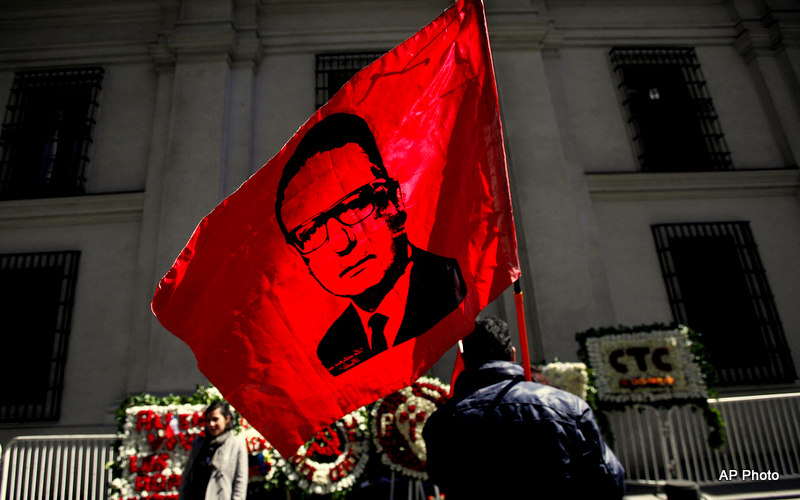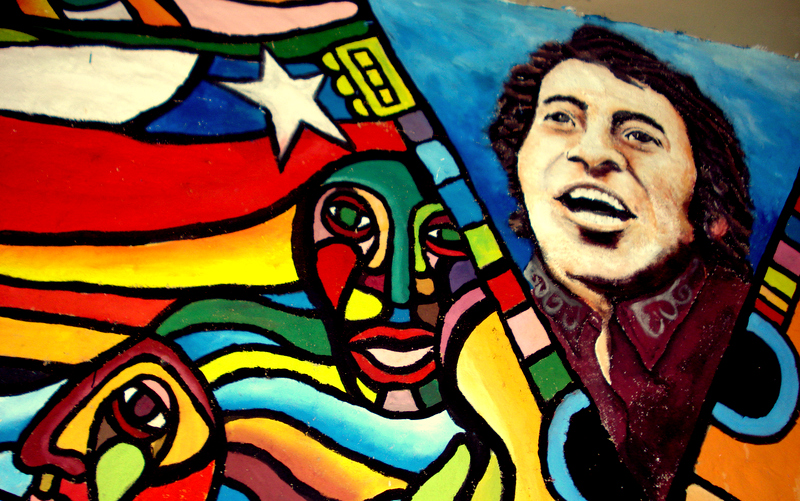
Sept. 11 marks the anniversary of a tragedy in Chile, and the immediate aftermath of this incident resulted in a multitude of horrific events that echo through history — even if they’re only starting to be acknowledged.
Following the suspicious circumstances of former President Salvador Allende’s death at the presidential palace La Moneda on Sept. 11, 1973, the military dictatorship immediately embarked upon a brutal annihilation of the left wing.
Within a few days of Allende’s death, the first detention and torture centers were established, among them Estadio Chile. This was later renamed Estadio Víctor Jara, in honor of the renowned nueva canción singer who died there at the brutal hands of agents previously enrolled in the notorious School of the Americas.
Nueva canción — the revolutionary folk music movement in Chile in the 1960s and 1970s — was considered a major threat to the Chilean right wing, particularly because of its links with Allende as well as the masses. The genre reflected the concerns of the poor and denounced social inequalities. Willingly aligning themselves with the left, nueva canción singers became a focal point of Allende’s electoral campaign. Their importance was clearly inscribed in one particular banner that stated, “There is no revolution without songs.”
The aftermath of the U.S.-backed coup revealed dictator Augusto Pinochet’s obsession with preventing the dissemination of culture. In 1970, Henry Kissinger had belligerently remarked, “I don’t see why we have to sit back and watch a country go communist due to the irresponsibility of its own people.” This so-called “irresponsibility” was an imperialist euphemism for the Chilean people’s participation in political life, as encouraged by Allende, as well as a reference to the possibility of socialist revolution sweeping across Latin America, thus threatening U.S. interests.
With the immediate threat — Allende’s socialist revolutionary process — out of the way, Pinochet’s dictatorship focused on the repression of cultural and intellectual material. Influential writers and intellectuals living in exile were kept under surveillance by the dictatorship, in case a formidable resistance against Pinochet formed abroad. The extent of surveillance is detailed in “Asociacion Ilícita: los archivos secretos de la dictadura” (“Illicit Association: The secret files of the dictatorship”), a book that expounds upon the intricate surveillance process and the links with foreign governments and agencies in order to maintain widespread suppression of dissenting voices.
In addition to burning material deemed subversive or intellectual, the dictatorship exiled touring nueva canción groups such as Inti Illimani and Quilapayun, while other singers, such as Angel Parra and Jara, were detained and brutally tortured. Parra was later released and exiled. Jara, however, was killed.
A revolution by music, murdered
Víctor Jara, who together with Isabel Parra, Angel Parra, Patricio Manns and Rolando Alarcon, is considered one of the founders of the nueva canción movement. He had been a target of the Chilean right wing prior to the movement’s participation in Allende’s electoral campaign. The songs, dealing with collective memory, anti-imperialist themes and social change, became a driving force for the working class and a vehement criticism of the Chilean right. Jara’s song “Preguntas por Puerto Montt” (“Questions about Puerto Montt”), performed in 1969, levelled direct criticism at the Chilean Ministry of Interior, which had ordered an attack on 91 peasant families occupying a stretch of wasteland.

In December 2012, Judge Miguel Vásquez of the Santiago Court of Appeals indicted two former National Intelligence Directorate, or DINA, agents – Pedro Pablo Barrientos Nuñez and Hugo Sanchez Marmonti — in Jara’s murder. Five other officers – Roberto Souper Onfray, Raúl Jofré González, Edwin Dimter Bianchi, Nelson Haase Mazzei and Luis Bethke Wulf — were also indicted for their complicity in the singer’s death.
The summary of accusations states that the above mentioned officers from the Tejas Verdes Regiment were involved in the detention of several people at Estadio Chile, including Jara.
Upon arriving at the stadium, the nueva canción singer was immediately recognized. He and Littre Quiroga — the prison director during Allende’s presidency — were separated from the other detainees and tortured in a particularly brutal manner. On Sept. 16, 1973, Jara was shot 44 times and his body was dumped outside the Metropolitan Cemetery with six other victims. Had his body not been recognized by a social activist during the early morning hours of that day, Jara would have become another one of Chile’s “disappeared.” However, soldiers were seen collecting the bodies to transport them to the morgue, whereupon Jara’s corpse was recognized by a worker, who was able to alert Joan Jara, Víctor’s widow, to her husband’s fate.
In August, Judge Vásquez indicted three other military personnel for the detention and murder of both Jara and Littre Quiroga. According to online newspaper Voz Ciudadana Chile, Hernán Chacón Soto and Patricio Vasquez Donoso were charged with detention and murder, while Ramón Melo Silva was charged as an accessory to the crime for his role in the cover-up.
Murder details emerge
Forty one years later, enough details of Jara’s murder have emerged to provide recapitulation of the horrors experienced by the singer in the overcrowded stadium.
While details, particularly those narrated by former conscript Jose Paredes, have established a sequence of events and identified those who participated in acts of torture and murder, the wider framework reveals a network of complicity including widespread impunity that can be traced back to the United States — notably the shelter offered to Jara’s alleged murderer, Pedro Pablo Barrientos Nuñez, as well as the role of the notorious School of the Americas in training many of the officers who later became an integral part of DINA.
“Quién Mató a Víctor Jara?” (“Who Killed Víctor Jara?”), a documentary aired on Chilevision last year, proved vital in piecing together intricate details. Departing from testimonies by former detainees at Estadio Chile, as well as a lengthy interview with former conscript Paredes, who divulged Barrientos’ name as the alleged murderer, the documentary shed greater light upon the atrocities committed against the nueva canción singer, as well as the agents involved directly in his torture and murder.
According to Paredes, Barrientos delivered what would ultimately be a fatal shot to Jaras’ head. “He shot him at almost point blank range because the man wouldn’t answer him.”
An international arrest warrant was issued by the Chilean courts for Barrientos, who has adamantly refused to travel to Chile since his name was revealed by Paredes as the alleged murderer. Chilean newspaper El Mostrador quoted Barrientos as stating, “I have never been in Estadio Chile. I don’t know Estadio Chile and I have no idea who Víctor Jara is. I will not submit myself to justice because i have killed no one.” (It is interesting to note that Barrientos had travelled freely to Chile since moving to the U.S. in the 1990s. The imperialist country has so far refused to cooperate with Chile’s extradition request for the alleged murderer of the nueva canción singer.)
It is worth noting that all the indicted officers formed part of the Tejas Verdes contingent, and some of them had taken courses at the School of the Americas. Tejas Verdes is known as the first torture and extermination center in Chile, and its agents would later head various specialized brigades and hold prominent positions in torture centers across the country.
The officers responsible for the carnage at Estadio Chile were under the direct command of DINA chief Manuel Contreras Sepulveda. While an under-researched subject until recently, it is imperative to keep Tejas Verdes as a focus for any investigations into human rights violations committed during Pinochet’s dictatorship. These investigations should also keep in mind another imperialist link — the School of the Americas and its training of many soldiers and lieutenants who later formed part of DINA.
School of Americas: Torture training camp made by the U.S.A.
According to SOA Watch, four of the officials indicted for Jara’s murder pursued courses at the School of the Americas. Barrientos and Raúl Jofré González were enrolled in the Officers’ Orientation course in 1968, while Edwin Dimter Bianchi and Jorge Smith Gumucio participated in the Combat Arms Course in 1970 and 1972, respectively.
Established in 1946 in Panama, the School of the Americas inscribed democracy as integral to its military training programs. Historically, democracy has been utilized by the U.S. as a fabricated pretext for overt and covert action in countries resisting imperialism — Latin America and the Middle East provide tangible examples of violence justified under the banner of democracy. The training school was later expelled from the country in 1984, with former Panamanian President Jorge Illueca describing it as “the biggest base for destabilization in Latin America.” Over 64,000 soldiers have been trained by the imperialist power notorious for its “enhanced interrogation techniques,” and many of these trained soldiers were later involved in the torture, deaths and disappearances of Latin American people resisting imperialist-supported dictatorships.
SOA Watch has also established that one out of every seven DINA agents had been enrolled in the school, including Miguel Krassnoff Martchenko. Krassnoff, a former torturer who specialized in the kidnapping, detention, torture and disappearance of Revolutionary Left Movement (MIR) and Communist party militants, is said to have been one of the agents who refused to hide his identity from his victims.
In 2001, the school was renamed the Western Hemisphere Institute for Security Cooperation. According to SOA Watch, the change remains superficial, with previous programs still in place. However, it is with regard to the memory framework that the projected difference between the School of the Americas and the institute should be analyzed.
A change of name, implying the termination of a previous program whose graduates have been involved in grave human rights violations, also reflects a memory lapse. Despite the documented violations and association of former agents with the School of the Americas, the disassociation between the former institution and its current incarnation ensures continued impunity for the entity and the graduates participating in the suppression of resistance in Latin America.

